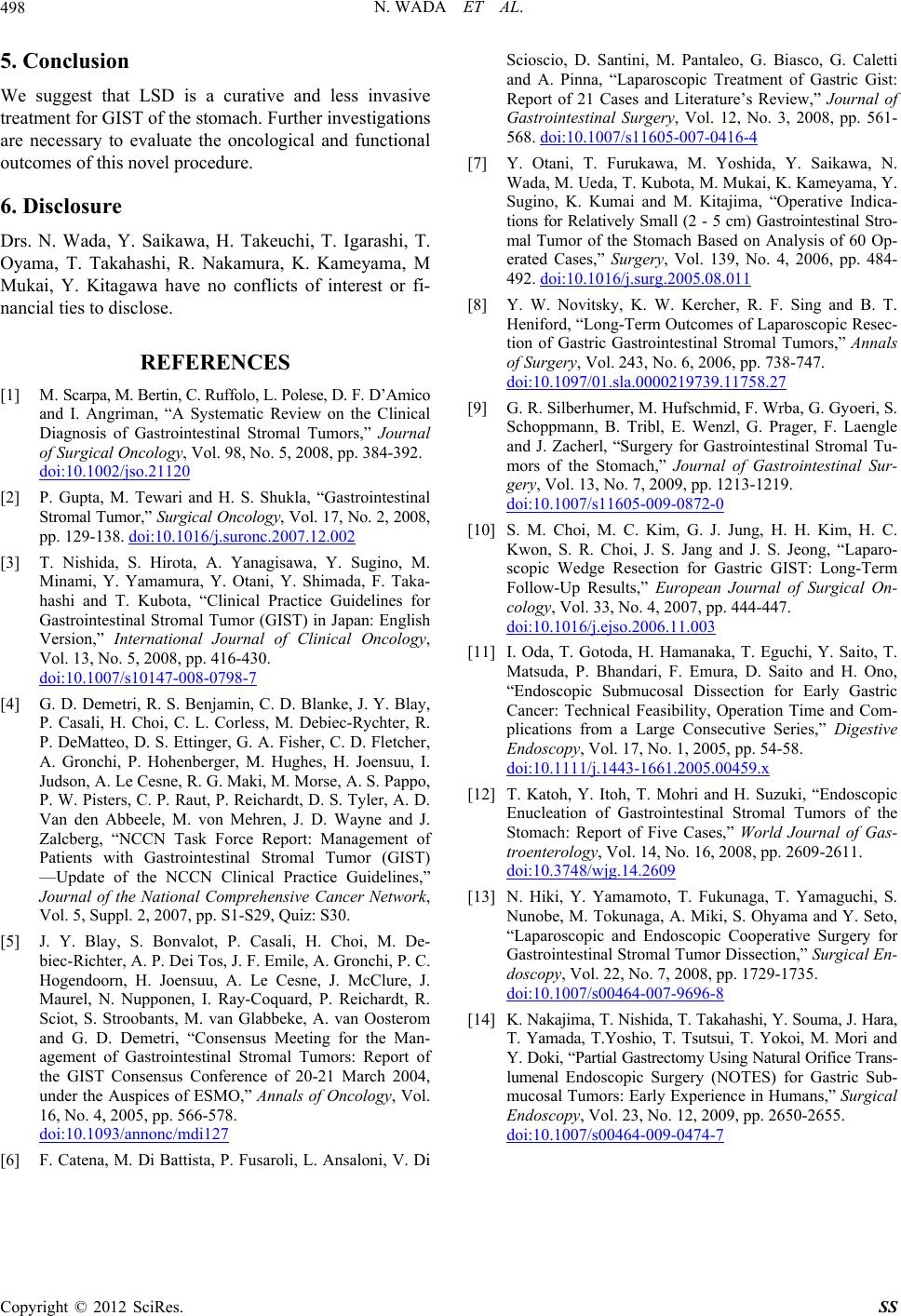
N. WADA ET AL.
Copyright © 2012 SciRes. SS
498
5. Conclusion
We suggest that LSD is a curative and less invasive
treatment for GIST of the stomach. Further investigations
are necessary to evaluate the oncological and functional
outcomes of this novel procedure.
6. Disclosure
Drs. N. Wada, Y. Saikawa, H. Takeuchi, T. Igarashi, T.
Oyama, T. Takahashi, R. Nakamura, K. Kameyama, M
Mukai, Y. Kitagawa have no conflicts of interest or fi-
nancial ties to disclose.
REFERENCES
[1] M. Scarpa, M. Bertin, C. Ruffolo, L. Polese, D. F. D’ Amic o
and I. Angriman, “A Systematic Review on the Clinical
Diagnosis of Gastrointestinal Stromal Tumors,” Journal
of Surgical Oncology, Vol. 98, No. 5, 2008, pp. 384-392.
doi:10.1002/jso.21120
[2] P. Gupta, M. Tewari and H. S. Shukla, “Gastrointestinal
Stromal Tumor,” Surgical Oncology, Vol. 17, No. 2, 2008,
pp. 129-138. doi:10.1016/j.suronc.2007.12.002
[3] T. Nishida, S. Hirota, A. Yanagisawa, Y. Sugino, M.
Minami, Y. Yamamura, Y. Otani, Y. Shimada, F. Taka-
hashi and T. Kubota, “Clinical Practice Guidelines for
Gastrointestinal Stromal Tumor (GIST) in Japan: English
Version,” International Journal of Clinical Oncology,
Vol. 13, No. 5, 2008, pp. 416-430.
doi:10.1007/s10147-008-0798-7
[4] G. D. Demetri, R. S. Benjamin, C. D. Blanke, J. Y. Blay,
P. Casali, H. Choi, C. L. Corless, M. Debiec-Rychter, R.
P. DeMatteo, D. S. Ettinger, G. A. Fisher, C. D. Fletcher,
A. Gronchi, P. Hohenberger, M. Hughes, H. Joensuu, I.
Judson, A. Le Cesne, R. G. Maki, M. Morse, A. S. Pappo,
P. W. Pisters, C. P. Raut, P. Reichardt, D. S. Tyler, A. D.
Van den Abbeele, M. von Mehren, J. D. Wayne and J.
Zalcberg, “NCCN Task Force Report: Management of
Patients with Gastrointestinal Stromal Tumor (GIST)
—Update of the NCCN Clinical Practice Guidelines,”
Journal of the National Comprehensive Cancer Network,
Vol. 5, Suppl. 2, 2007, pp. S1-S29, Quiz: S30.
[5] J. Y. Blay, S. Bonvalot, P. Casali, H. Choi, M. De-
biec-Richter, A. P. Dei Tos, J. F. Emile, A. Gronchi, P. C.
Hogendoorn, H. Joensuu, A. Le Cesne, J. McClure, J.
Maurel, N. Nupponen, I. Ray-Coquard, P. Reichardt, R.
Sciot, S. Stroobants, M. van Glabbeke, A. van Oosterom
and G. D. Demetri, “Consensus Meeting for the Man-
agement of Gastrointestinal Stromal Tumors: Report of
the GIST Consensus Conference of 20-21 March 2004,
under the Auspices of ESMO,” Annals of Oncology, Vol.
16, No. 4, 2005, pp. 566-578.
doi:10.1093/annonc/mdi127
[6] F. Catena, M. Di Battista, P. Fusaroli, L. Ansaloni, V. Di
Scioscio, D. Santini, M. Pantaleo, G. Biasco, G. Caletti
and A. Pinna, “Laparoscopic Treatment of Gastric Gist:
Report of 21 Cases and Literature’s Review,” Journal of
Gastrointestinal Surgery, Vol. 12, No. 3, 2008, pp. 561-
568. doi:10.1007/s11605-007-0416-4
[7] Y. Otani, T. Furukawa, M. Yoshida, Y. Saikawa, N.
Wada, M. Ueda, T. Kubota, M. Mukai, K. Kameyama, Y.
Sugino, K. Kumai and M. Kitajima, “Operative Indica-
tions for Relatively Small (2 - 5 cm) Gastrointestinal Stro-
mal Tumor of the Stomach Based on Analysis of 60 Op-
erated Cases,” Surgery, Vol. 139, No. 4, 2006, pp. 484-
492. doi:10.1016/j.surg.2005.08.011
[8] Y. W. Novitsky, K. W. Kercher, R. F. Sing and B. T.
Heniford, “Long-Term Outcomes of Laparoscopic Resec-
tion of Gastric Gastrointestinal Stromal Tumors,” Annals
of Surgery, Vol. 243, No. 6, 2006, pp. 738-747.
doi:10.1097/01.sla.0000219739.11758.27
[9] G. R. Silberhumer, M. Hufschmid, F. Wrba, G. Gyoeri, S.
Schoppmann, B. Tribl, E. Wenzl, G. Prager, F. Laengle
and J. Zacherl, “Surgery for Gastrointestinal Stromal Tu-
mors of the Stomach,” Journal of Gastrointestinal Sur-
gery, Vol. 13, No. 7, 2009, pp. 1213-1219.
doi:10.1007/s11605-009-0872-0
[10] S. M. Choi, M. C. Kim, G. J. Jung, H. H. Kim, H. C.
Kwon, S. R. Choi, J. S. Jang and J. S. Jeong, “Laparo-
scopic Wedge Resection for Gastric GIST: Long-Term
Follow-Up Results,” European Journal of Surgical On-
cology, Vol. 33, No. 4, 2007, pp. 444-447.
doi:10.1016/j.ejso.2006.11.003
[11] I. Oda, T. Gotoda, H. Hamanaka, T. Eguchi, Y. Saito, T.
Matsuda, P. Bhandari, F. Emura, D. Saito and H. Ono,
“Endoscopic Submucosal Dissection for Early Gastric
Cancer: Technical Feasibility, Operation Time and Com-
plications from a Large Consecutive Series,” Digestive
Endoscopy, Vol. 17, No. 1, 2005, pp. 54-58.
doi:10.1111/j.1443-1661.2005.00459.x
[12] T. Katoh, Y. Itoh, T. Mohri and H. Suzuki, “Endoscopic
Enucleation of Gastrointestinal Stromal Tumors of the
Stomach: Report of Five Cases,” World Journal of Gas-
troenterology, Vol. 14, No. 16, 2008, pp. 2609-2611.
doi:10.3748/wjg.14.2609
[13] N. Hiki, Y. Yamamoto, T. Fukunaga, T. Yamaguchi, S.
Nunobe, M. Tokunaga, A. Miki, S. Ohyama and Y. Seto,
“Laparoscopic and Endoscopic Cooperative Surgery for
Gastrointestinal Stromal Tumor Dissection,” Surgical En-
doscopy, Vol. 22, No. 7, 2008, pp. 1729-1735.
doi:10.1007/s00464-007-9696-8
[14] K. Nakajima, T. Nishida, T. Takahashi, Y. So uma, J. Hara,
T. Yamada, T.Yoshio, T. Tsutsui, T. Yokoi, M. Mori and
Y. Doki, “Partial Gastrectomy Using Natural Orifice Trans-
lumenal Endoscopic Surgery (NOTES) for Gastric Sub-
mucosal Tumors: Early Experience in Humans,” Surgical
Endoscopy, Vol. 23, No. 12, 2009, pp. 2650-2655.
doi:10.1007/s00464-009-0474-7